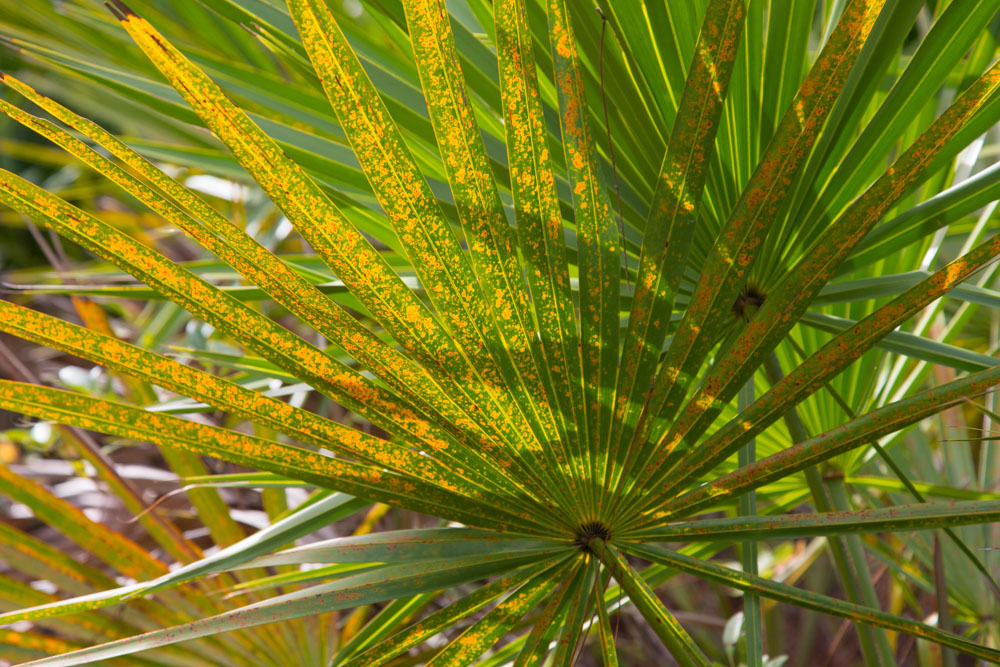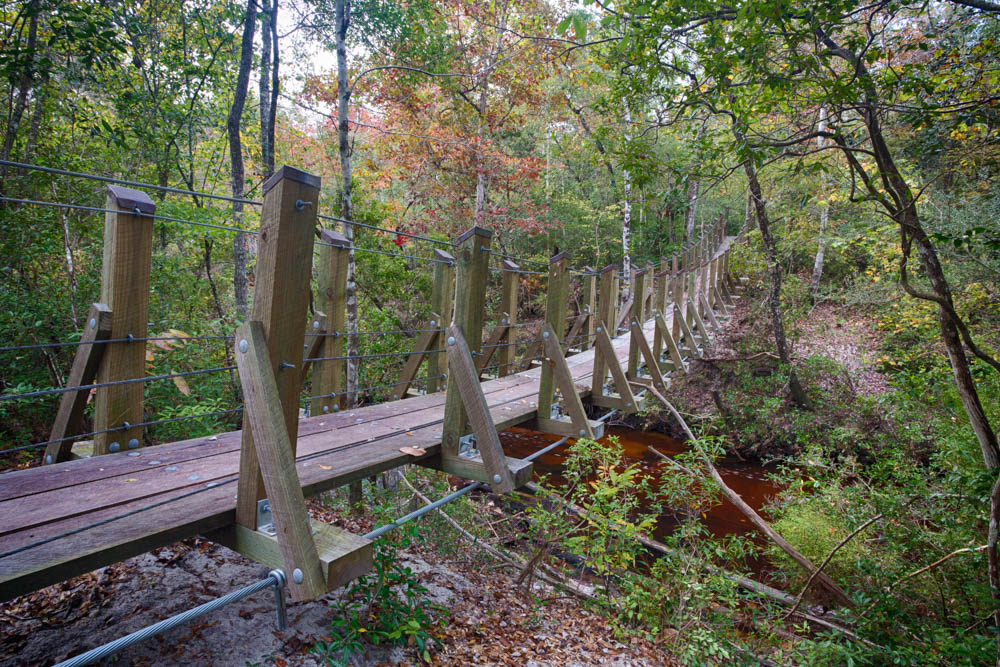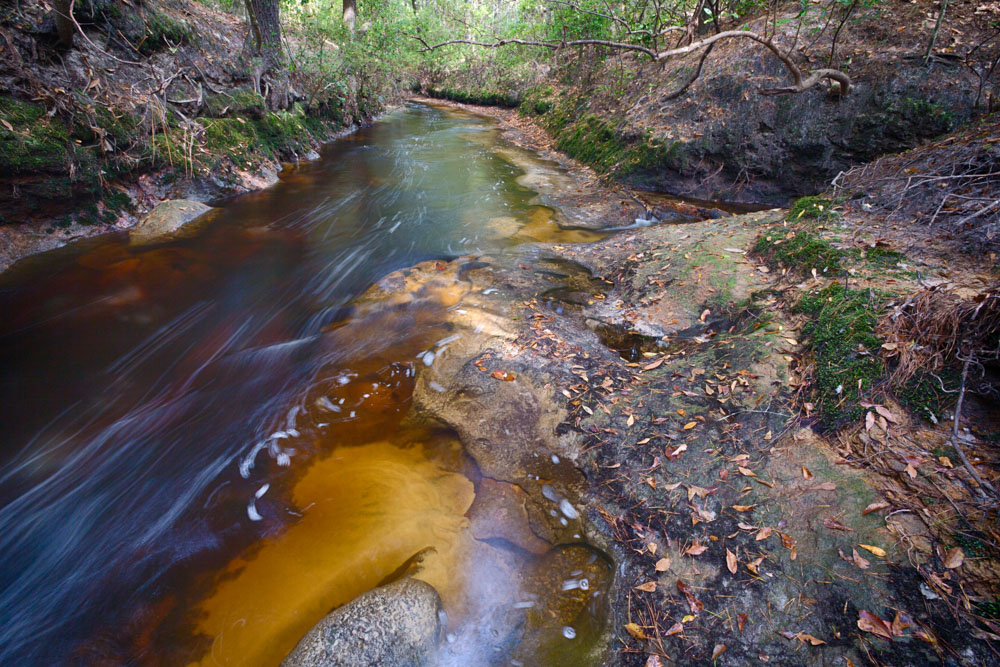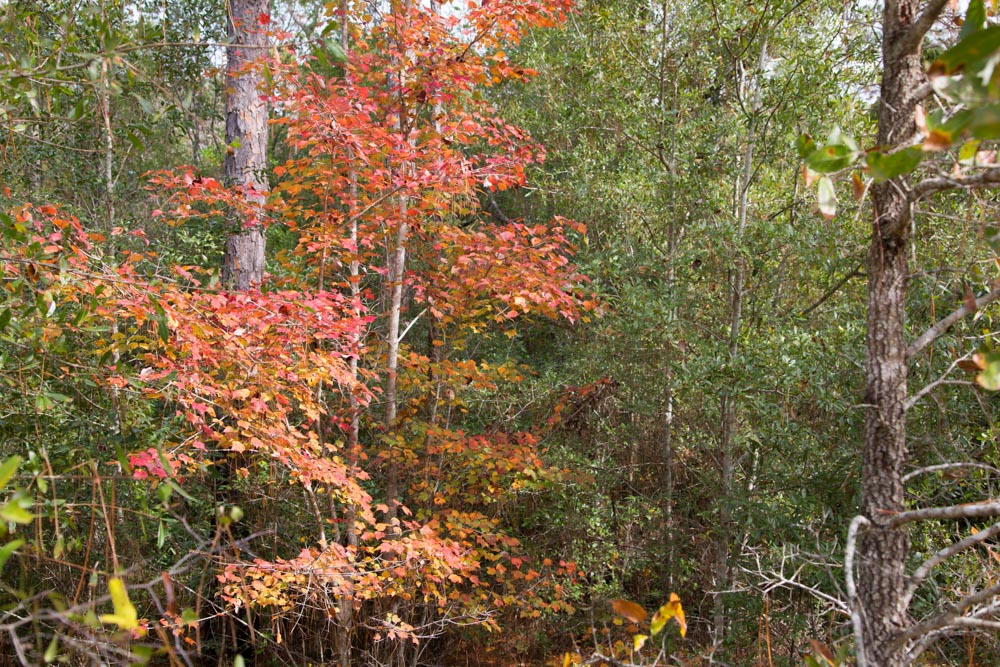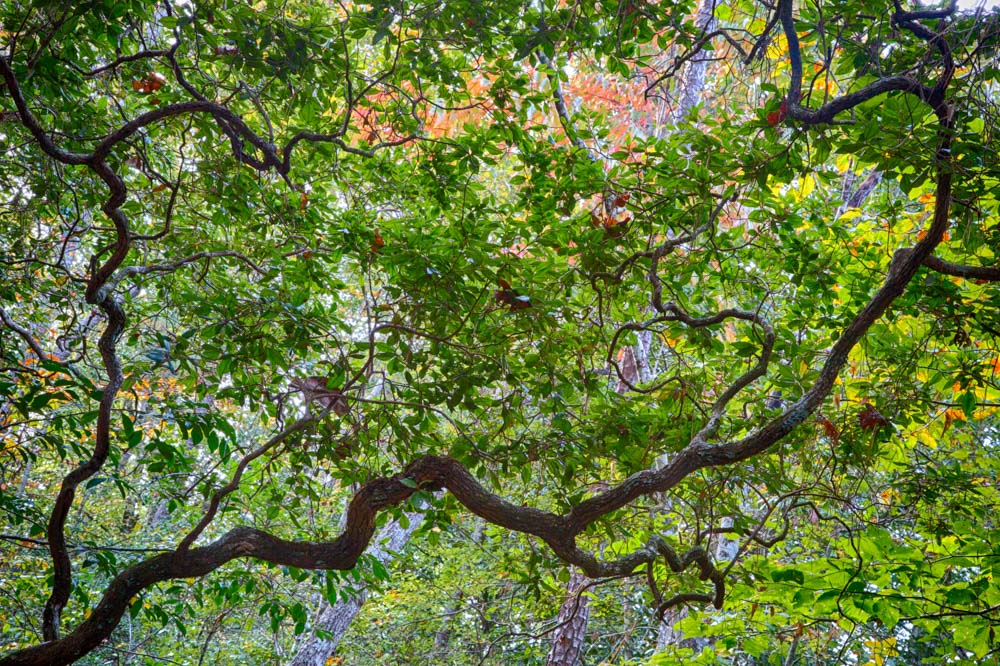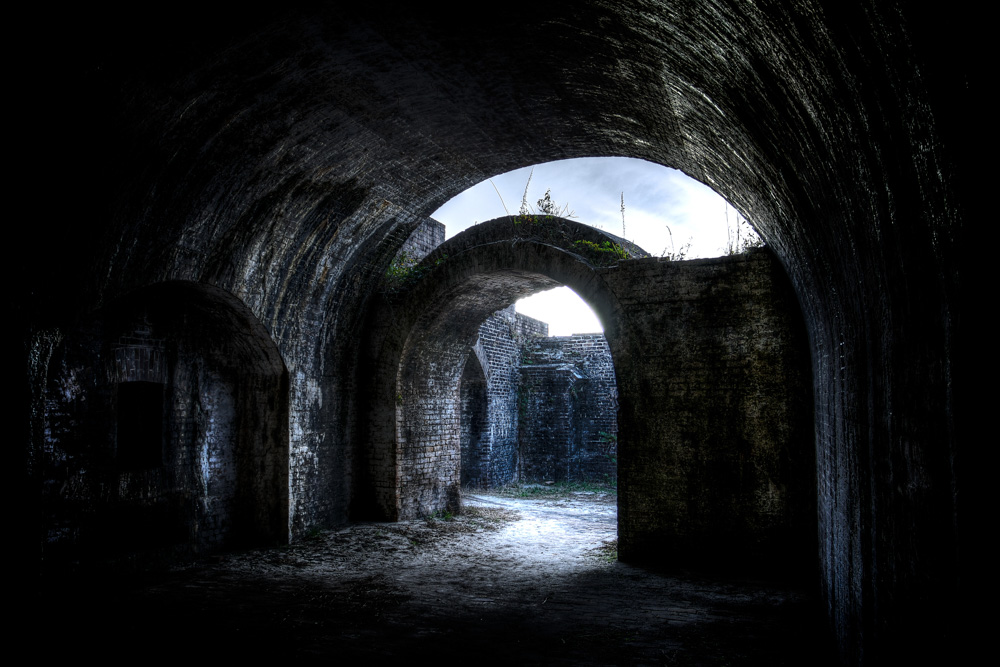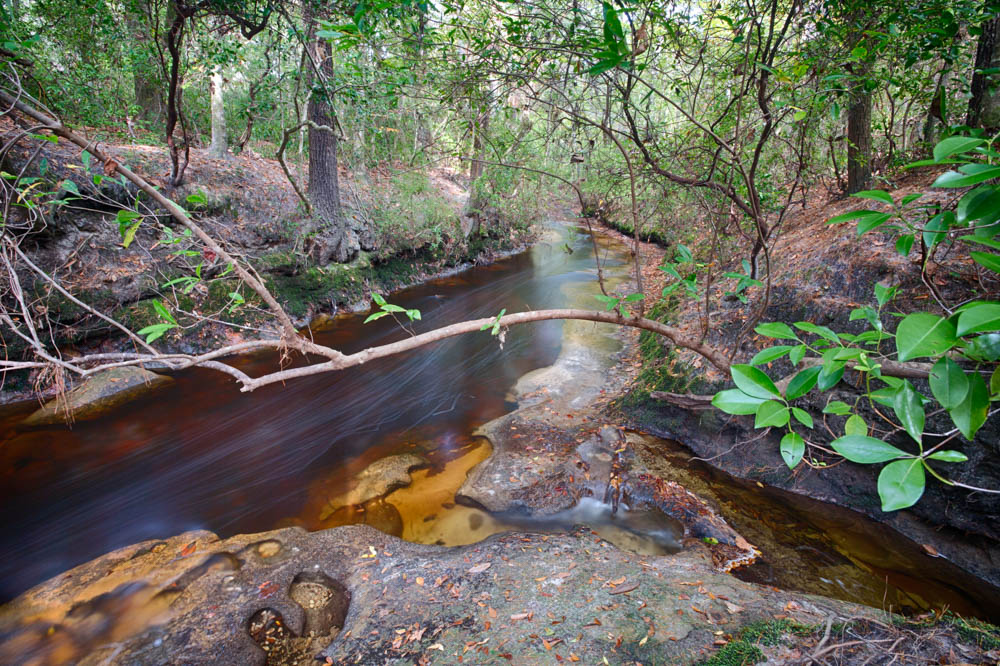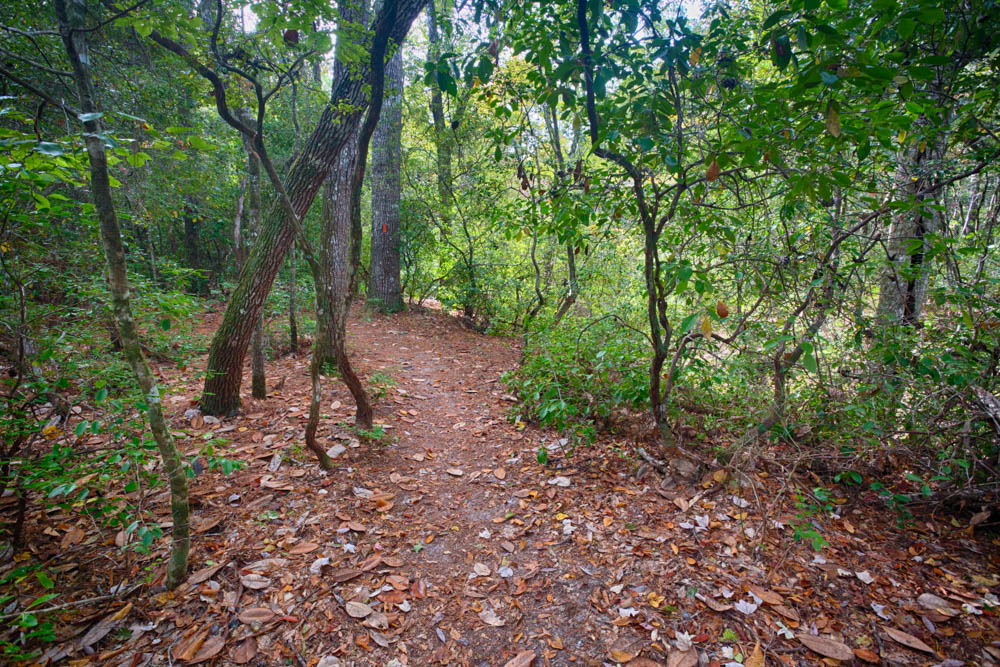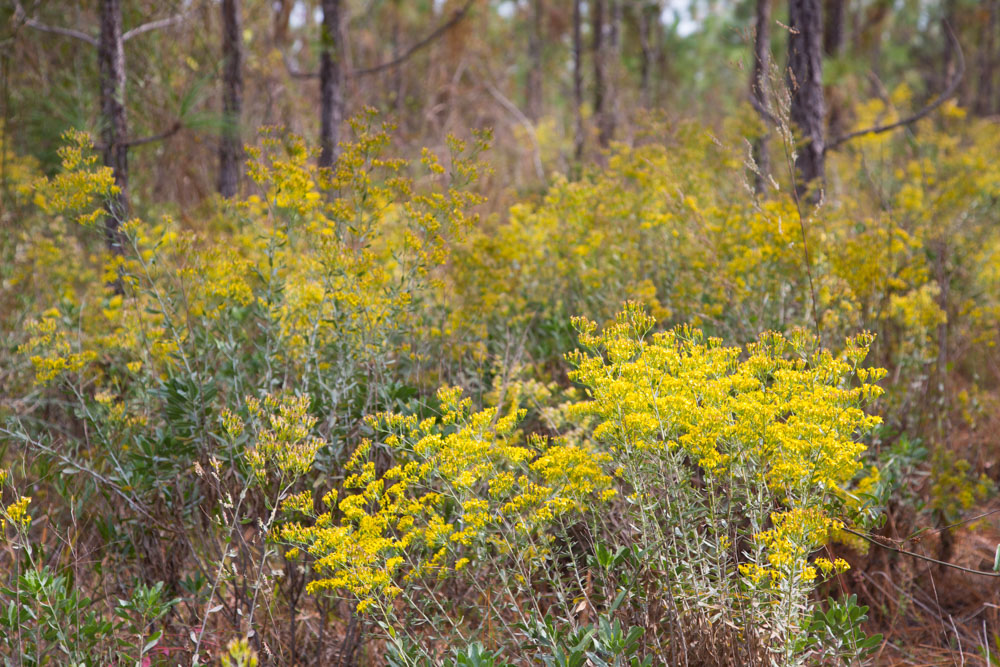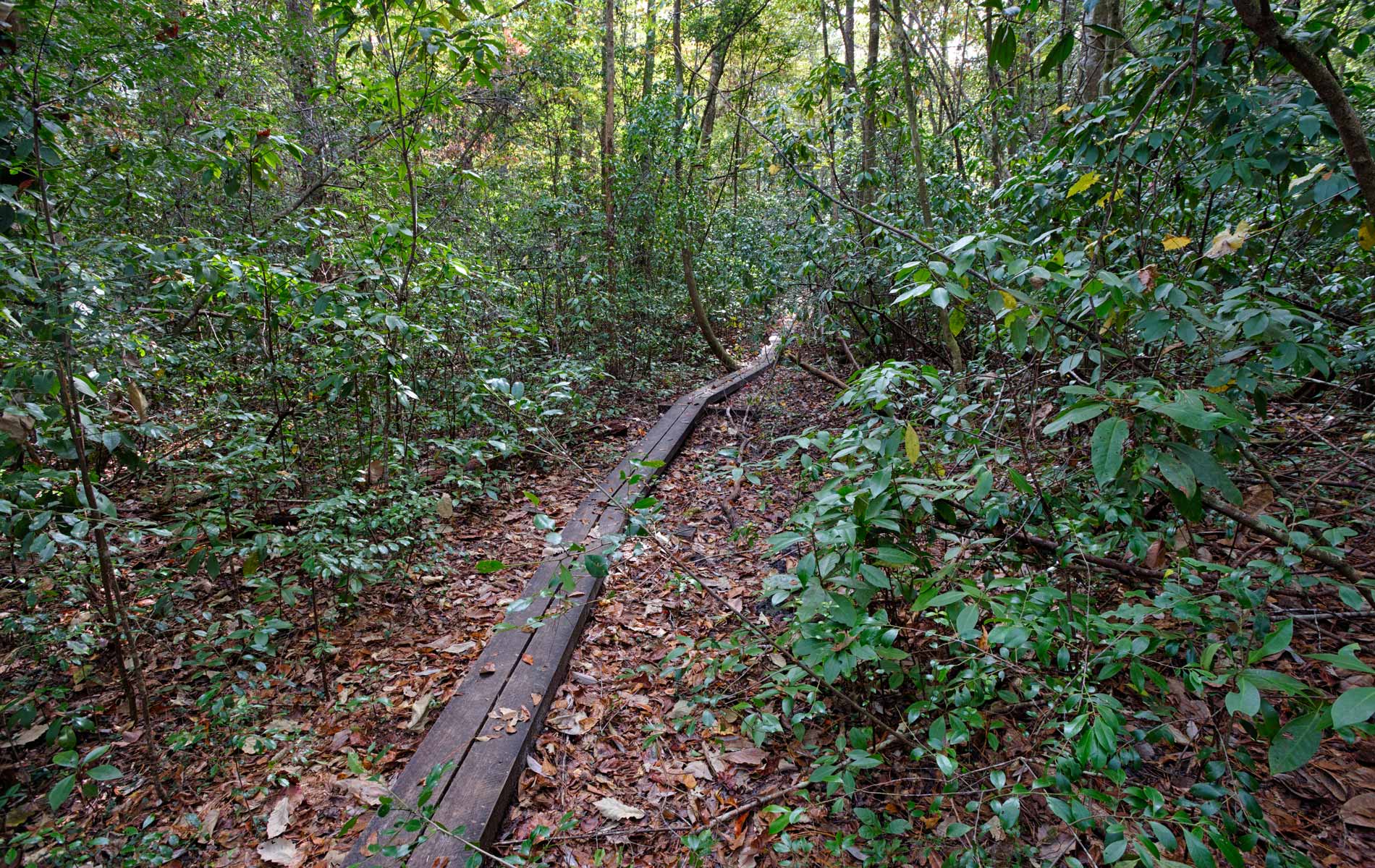
vie-magazine-florida-trail
Up Close and Personal
By Anne W. Schultz | Photography by David Moynahan
Soft, white sand cushions my hiking boots, feathery grass tickles my bare legs, and the morning sun warms my face as I traipse down a shoestring of a trail through a meadow of wildflowers. Waist-high golden asters billow up among tawny grasses, their masses of tiny flowers a dazzling sunshine yellow that is bright enough to attract the monarch butterflies that migrate through in the fall. The cloudless sulphur, a butterfly species native to Florida, flutters by in a current of air that captures the honey-sweet perfume of flowering earth. A cardinal sings from a nearby gallberry bush while an ant colony swarms near my feet.
My husband, Bill, and I are hiking the Econfina Creek section of the Florida National Scenic Trail, engaging our senses as we walk: ogling the beauty, listening for subtle sounds, breathing in scents, and touching various textures, the way humans did for thousands upon thousands of years traveling on foot, before automobiles became the customary mode of transportation. Nowadays, we zoom past in cars or trucks with windows rolled up, air-conditioning on, and possibly a radio blaring—perhaps glancing at the scenery through the window, yet far removed from the sensual pleasures that our ancestors enjoyed. Our intimate connection with the natural world has, in many cases, been lost, but can be regained one step at a time by hiking a wilderness trail.
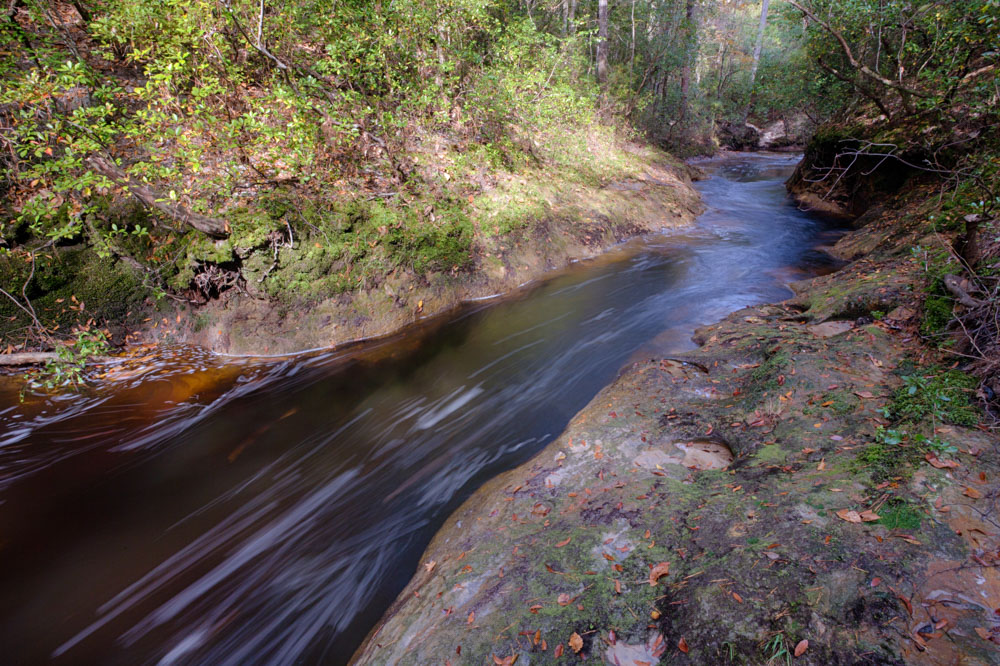
Wild: From Lost to Found on the Pacific Crest Trail, the recent best-selling memoir recounting author Cheryl Strayed’s life-changing journey, has spurred a resurgence in trail walking, not only for the obvious reasons of beautiful scenery, exercise, and outdoor adventures, but also for the additional therapeutic benefits of self-discovery and introspection that are nourished by tramping through the wilderness. The Florida Trail doesn’t traverse mountainous grandeur like the Pacific Crest Trail, but its astonishing biodiversity still makes it stand out from other National Scenic Trails. “Mountains may provide vistas and provoke contemplation on the larger universe, but the Florida landscape is so much more intimate,” explains Megan Eno, who works as partnership coordinator for the US Forest Service. “The intense contrast of an orchid in a swamp brings you to contemplate the individual, the importance of self.”
The trail stretches for thirteen hundred miles up and down the state, through twenty-eight different ecosystems from Big Cypress National Preserve swamps to the sparkling quartz sand beaches of Gulf Islands National Seashore. The amazing variety is what makes the Florida Trail truly unique—it is a trail that keeps you wide-eyed and fascinated, wondering what in the world you’ll stumble across next. Maybe wildlife? “The trail not only connects all Florida landscapes, providing access to the real Florida for people, but it’s also an important wildlife corridor crossing the state,” Eno says. She shares what others have told her about the trail. “It’s the best way to see Florida. You’re in it; you can reach out and touch, and it touches you back,” said someone who hiked the entire trail. “The trail literally saved my life,” said another hiker recovering from severe obesity issues.
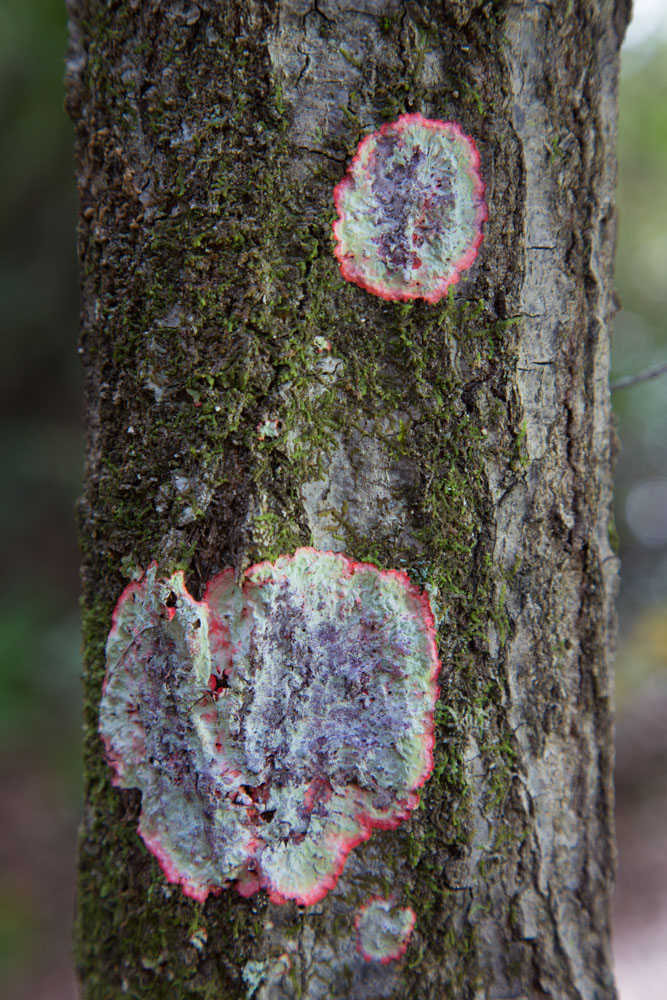
Our intimate connection with the natural world has, in many cases, been lost, but can be regained one step at a time by hiking a wilderness trail.
“I rank Econfina Creek in the Northwest Florida Panhandle as one of the top ten trails to hike,” advises Tom Daniel, vice president of the Florida Trail Association. “The eighteen-mile trail leads hikers up rugged bluffs overlooking Econfina Creek. In springtime, you come across rhododendron and mountain laurel that make it feel more like the Appalachian foothills than Florida. It’s a Florida few people realize exists.”
Back in 1966, one man’s passion for hiking and sheer frustration at the lack of trails paved the way for the Florida Trail. Wildlife photographer and real estate broker Jim Kern became sick and tired of “driving all the way to North Carolina to hike the wilderness” because there were no trails in his home state of Florida. “I felt strongly that Florida was missing out not having any footpaths,” says Kern in a website history of the Florida Trail Association. “The Forest Service thought it was all a joke. They told me go ahead and do your thing, but no one will want to hike Florida.” To draw attention to his cause, Kern hiked from the Tamiami Trail to Highlands Hammock State Park near Sebring, a one-hundred-sixty-mile journey that took twelve days.
Eventually, the Florida Trail will hook up with a spur trail currently under construction in Alabama, which will connect with the Appalachian Trail, making it possible to walk four thousand miles from Florida to Canada.
Like-minded hiking enthusiasts responded from all over Florida. Many, like Kern, were eager to delve deeper than Disney World tourism and explore the wild heart of their wondrous state. In an energetic grassroots movement, these original respondents took matters into their own hands and started the Florida Trail Association, which still maintains the trails today. There were often no paths to follow, so these volunteers hacked their own, swinging machetes and marking trails with slashes of orange paint that they brushed on tree trunks. They braved snakes, mosquitoes, and high humidity—among other things—to make their dreams a reality. The abundant rainfall and warm temperatures of the Sunshine State make trail maintenance a constant effort. “You are never finished maintaining the trail,” says Daniel. “It’s the people who make it happen with their selfless devotion of time and resources. Today, over five thousand volunteers belonging to eighteen chapters keep trails groomed for the three hundred and fifty thousand hikers and backpackers who visit every year.”
Their efforts led to the 1983 congressional approval of the Florida Trail as one of the eleven National Scenic Trails, which are considered the ultimate hiking paths in America. Congress designated the USDA Forest Service as the administrative agency that oversees the trail. Along with the original Florida Trail Association, a variety of federal and state agencies, national wildlife preserves, national and state parks, military lands, and private owners all interact to keep the trail, a visible work in progress, thriving and expanding. Eventually, the Florida Trail will hook up with a spur trail currently under construction in Alabama, which will connect with the Appalachian Trail, making it possible to walk four thousand miles from Florida to Canada.
Late fall to early spring are the best times for hiking any section, as temperatures cool down, rainfall lessens, snakes and insects are less active, and migratory wildlife is abundant. Here is a snapshot of some things you can encounter along the way:
SOUTH FLORIDA
Florida panthers roam the South Florida section cutting through Big Cypress National Preserve, a timeless vista reminiscent of Africa’s golden savannas; the preserve’s sweeping expanse of sawgrass prairies and pond cypress swamps look as prehistoric as the alligators living there. The first forty miles feel like a tropical jungle as they meander through giant ferns, bromeliads, and orchids. Farther north, the trail passes through the Everglades, the only spot in the world where rainwater moves in sheets to the Gulf of Mexico through miles of Jamaica sawgrass. Then, the trail circles Lake Okeechobee, the second-largest freshwater lake in the country. It goes on to parallel the Kissimmee River and visits the abandoned homesteads of early settlers before ending at Three Lakes Wildlife Management Area, where sandhill cranes abound.
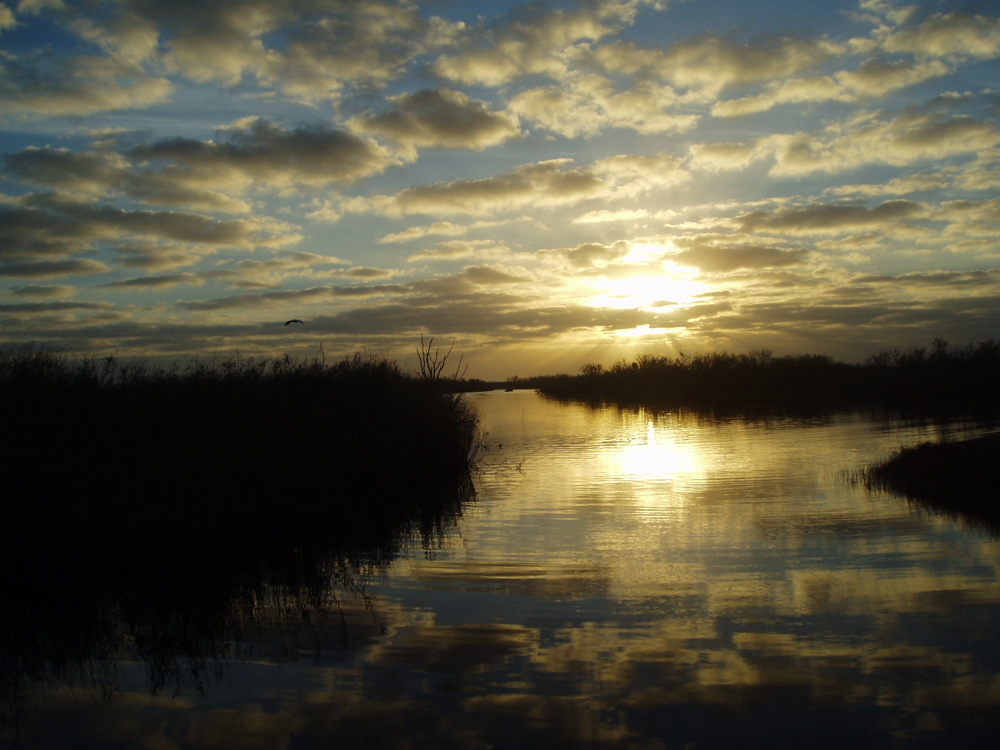
Fisheating Creek at sunrise in South Florida; Photo by Robert Coveney of the FTA
CENTRAL FLORIDA
In Central Florida, the trail splits into eastern and western corridors that loop around heavily populated cities. The trails reconnect at Ocala National Forest, where volunteers built the first segment of the Florida Trail. The eastern corridor takes hikers through palmetto prairies, pine flatwoods, open prairies, and hammocks. Along the way, you can visit a rare stand of virgin bald cypress at Tosohatchee State Preserve as well as one of the oldest and tallest cypress trees in the world. Keep an eye out for Florida black bears! The western corridor takes hikers into the wilderness region of the Green Swamp through the pine flatwoods, sandhills, and floodplain forest of the Withlacoochee River. Later, you parallel the route Hernando de Soto used when exploring Florida. It’s possible to see sandhill cranes and wood storks along this western route. A backpacker favorite is the seventy-mile route through the largest sandhill forest in the world, along with a dip in one of the glorious springs.
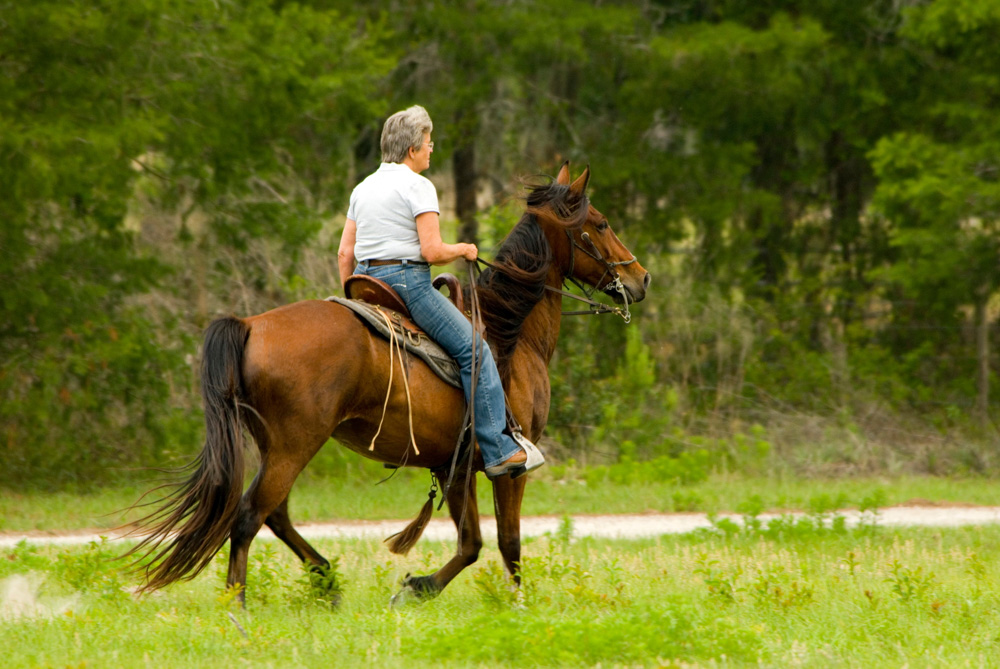
Horseback riding in Central Florida; Photo by M. Timothy O’Keefe of the Florida Trail Association
NORTH FLORIDA
The scenic trails of northern Florida visit some historical sites: an eighteenth-century indigo and rice plantation set beneath ancient cypress trees; and the site where Florida fought its largest Civil War battle. It takes you over ravines lush with dogwoods and azaleas in the spring and through thick oak forests at Gold Head Branch State Park. You might see the endangered red-cockaded woodpecker in Osceola National Forest. You’ll develop your hiking skills by navigating the ups and downs of high bluffs along the Suwannee River, considered one of Florida’s most beautiful due to its white-sand beaches and waterfalls. At the Aucilla River, you’ll witness a unique phenomenon: the river disappears underground and then reappears through “windows” in the limestone aquifer. St. Marks National Wildlife Refuge provides a haven for wildlife where Florida black bears along with countless birds are routinely sighted year-round. The wildlife refuge also boasts salt marshes and isolated forests.
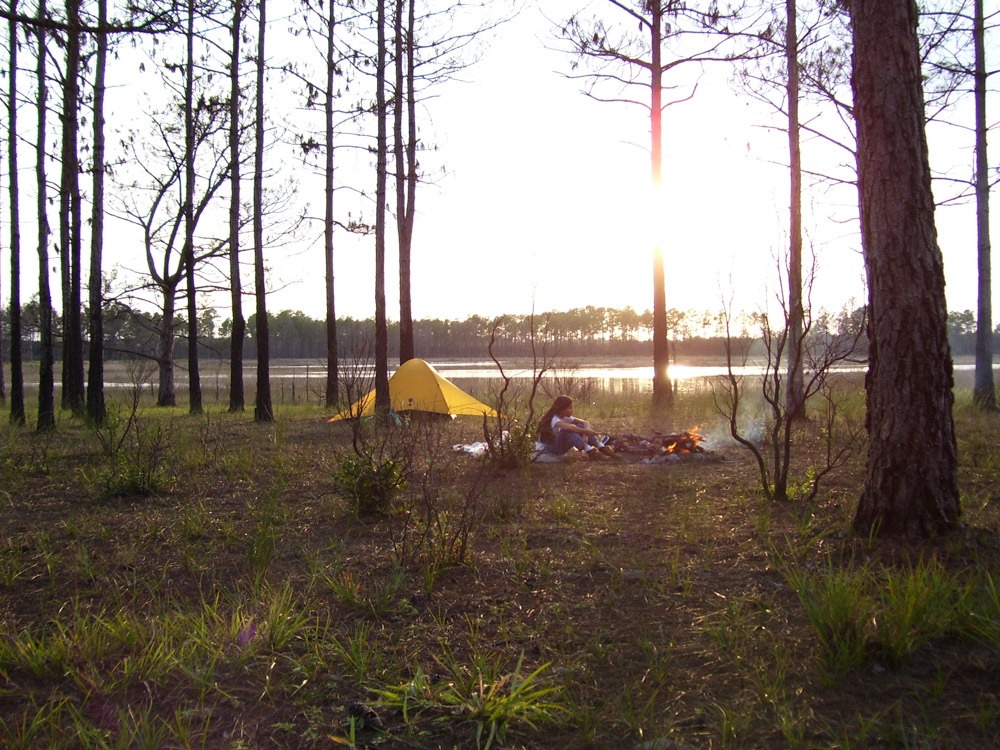
Camping at Hidden Pond in North Florida; Photo by Lenny Chew of the FTA
THE FLORIDA PANHANDLE
The trail back at Econfina Creek climbs up and away from the wildflower meadow into a big surprise. You suddenly feel like Alice falling into a rabbit hole and landing in a completely unexpected wonderland as you’re swallowed up by dense hardwood forest. You can not only see how changes in elevation—even slight ones—alter the landscape, but also feel it as the temperature dips by about ten degrees. Patches of lichen feel velvety and moist to your fingertips, and scores of mushrooms pop from fertile rich soil beneath your feet. Canopy trees tower above while their lower branches encircle you. You’ll find yourself cocooned in a quiet and peaceful sanctuary—a refuge from the cares and troubles of the world you left behind only thirty minutes before.
For those who think Florida is only palm trees and beaches, this place is a shocker. Who would expect an uphill hike in a state famed for sea-level vistas, or to discover that trees native to the Appalachian foothills also flourish here along ridges above a creek? Spring is glorious when these unexpected trees—redbuds, dogwoods, mountain laurels, and rhododendrons—burst into riotous color, and native oakleaf hydrangeas spill waterfalls of white blossoms over limestone banks. In cooler months, a Florida maple flames a more intense, fiery red than its northern relative against a background of glossy greens, adding a splash of Appalachian fall color to the scenery.
Sunlight streams through scattered openings in the canopy, casting shady silhouettes of leaf and branch patterns across the sunlit path. Clumps of silvery-green deer moss indicate drier ground as you climb higher toward limestone ledges and the sound of gurgling water. From the bluffs, look down at sparkling amber-colored water cascading in ripples down narrow rock chutes, which make this the most challenging and highest canoe trail in Florida—recommended for experienced canoeists only!
Archaeologists have discovered a hundred and twenty Native American sites in this region alone, some dating back to the end of the Ice Age. The Muskogee tribe named the creek Econfina, a word meaning “natural bridge.” These original inhabitants had a total dependence on creeks, rivers, and springs as their only large source of freshwater. It’s the same today, but we lose sight of that when all we have to do is turn on a faucet. Our ancestors revered the natural world as a sacred gift provided by a benevolent Creator. At least eleven spring groups feeding millions of gallons of water through this creek testify to God’s bountiful supply.
- Fort Pickens at Gulf Islands National Seashore in Florida’s Pandhandle; Photo by Bill Weckel
I’ve discovered that hiking a wilderness trail not only empowers you, but also leads you back home to your authentic inner self.
Like Cheryl Strayed and countless others, I’ve discovered that hiking a wilderness trail not only empowers you, but also leads you back home to your authentic inner self. It awakens a wild adventurous spirit within—an intuitive, playful child that feels fully alive in these safe surroundings that set it free. Expand your horizons and spice up your life with the abundant variety offered on the Florida National Scenic Trail. Lace up your hiking boots and head out. You never know where the next step will lead when you follow the orange blazes down this corridor of life.
— V —
Read these books to enrich your trail experiences:
Priceless Florida: Natural Ecosystems and Native Species – Beautifully written by experts Ellie Whitney, D. Bruce Means, and Anne Rudloe, this comprehensive overview of Florida nature is fascinating to read.
Hiking the Florida Trail by Johnny Molloy
The Florida Trail: The Official Hiking Guide by Sandra Friend
For volunteer and trail information, visit www.floridatrail.org or call 352-378-8823. For trail information and interpretive mapping tools, visit www.fs.usda.gov/FNST. For an inspiring video, check out www.youtube.com/watch?v=igVhLjq56DE
Share This Story!
KEEP UP WITH THE LATEST STORIES FROM VIE



